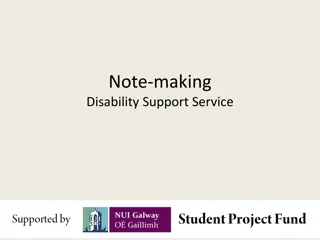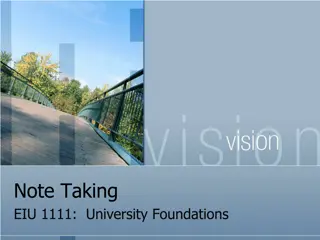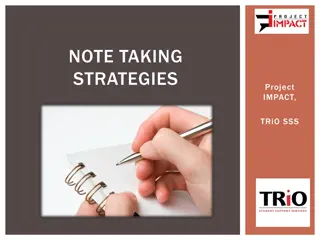Effective Note-Taking Strategies for Academic Success
Enhance your note-taking skills with guidance from Moorpark College Writing Center. Learn the process of note-taking, including observing the instructor and yourself, recording key words, using image prompting, mapping, Cornell Method, and summarization. Understand the importance of reviewing notes within 24 hours and selecting a method tailored to your course, instructor, and learning style.
Download Presentation

Please find below an Image/Link to download the presentation.
The content on the website is provided AS IS for your information and personal use only. It may not be sold, licensed, or shared on other websites without obtaining consent from the author.If you encounter any issues during the download, it is possible that the publisher has removed the file from their server.
You are allowed to download the files provided on this website for personal or commercial use, subject to the condition that they are used lawfully. All files are the property of their respective owners.
The content on the website is provided AS IS for your information and personal use only. It may not be sold, licensed, or shared on other websites without obtaining consent from the author.
E N D
Presentation Transcript
Taking Lecture Notes Presented by Moorpark College Writing Center
The Process of Note-Taking 3. 1. Review Observe 2. Record
Observe Instructor: Tone of voice Leading words Pauses Body language Teaching Style Self: Energy level Attention Prior knowledge Emotional reactions Learning Style
Observing the Instructor What clues does the instructor give? What is on the board? Body Leading Words? Language?
Observing Self Am I Visual? MCj00787110000[1] I learn by talking and listening Am I auditory? I learn by seeing Am I kinesthetic? I learn by doing
Record Key Words Image prompting Mapping Cornell Method Summarize/ Paraphrase Outline
Example of Key Words Note-Taking 3 step process Observe Record review
Example of Image Prompting Note-Taking = Observe Record Review
Example of Cornell: This is not really a preferred method. Given the idea of seeing the connections , why do you think this isn t so great? Observe the teacher: Body language, clues, teaching style Observe Observe self: learning style, attention Record Select a method that works for the course, the instructor and for me. Review Within 24 hours, go over notes, look for unknowns And then make it real (visual, auditory, kinesthetic)
Example of a Summarizing Method Taking notes requires watching and listening actively, Writing down what is important, and then making it real. Need to take the Learning Styles Inventory. Education is a process not a product, Kathryn Adams
Outline I. Note-Taking A. Observe B. Record C. Review
Example of Mapping Note-Taking Observe Record Review
Review Check for Accuracy: Compare notes with other students; compare notes to text; ask questions at office hours Organize: Fill in missing links; create a map of associated topics Synthesize: Look at the context of the class (the Big Picture) Make it Real: Talk about it. Act upon it. Apply it to experience. See it in your world.
Quick Tips on Textbook Notes Read chapter titles and headings. Turn chapter titles & headings into questions Seek the answers Chapter 2. Learning styles Just as there are many different personalities in the world there are many different ways of learning. These ways of learning are sometimes called Learning Styles. Dunn and Dunn proposed three styles: Visual, Auditory and Kinesthetic.
More tips on annotating Write brief summaries of each section or key words in the margins (or on post its) Use your own words. Add your thoughts, connections, questions Chapter 2. Learning styles Just as there are many different personalities in the world there are many different ways of learning. These ways of learning are sometimes called Learning Styles. Dunn and Dunn proposed three styles: Visual, Auditory and Kinesthetic. L.S. = Ways of learning Find D&D primary text. 3: Vis, Aud, Kin I m auditory/visual
Reading Log I noticed/saw I thought or made connections with) I wondered or want to know more about
Prepare Think as a teacher Turn your notes (answers) into questions Add questions that force you to go further Reword the questions so that your mind must see them another way. Study Smart Create a routine of study Take breaks Review and then APPLY























